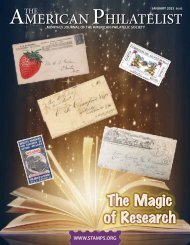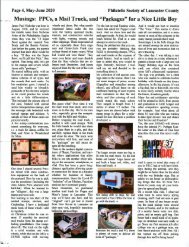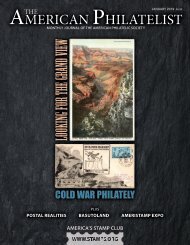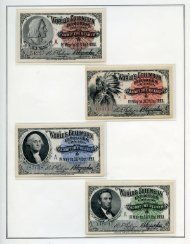February 2018 - Sneak Peek
The American Philatelist is the monthly journal of the American Philatelic Society, the world's largest organization for stamp collectors and enthusiasts. Members receive the printed magazine and can access the digital edition as a benefit of membership in the Society. Please enjoy this sneak peek. We're confident that once you see all that we offer, you'll want to join the APS today.
The American Philatelist is the monthly journal of the American Philatelic Society, the world's largest organization for stamp collectors and enthusiasts. Members receive the printed magazine and can access the digital edition as a benefit of membership in the Society. Please enjoy this sneak peek. We're confident that once you see all that we offer, you'll want to join the APS today.
You also want an ePaper? Increase the reach of your titles
YUMPU automatically turns print PDFs into web optimized ePapers that Google loves.
the one from October 5 in which the letter-writer talks about<br />
marking his 29th birthday – contains two sheets of writing<br />
paper.<br />
The letters truly are of the sort that are heavy on the writer’s<br />
emotions of love and lonesomeness for his sweetheart –<br />
he always signs “I am forever yours” – and offers sparse facts<br />
about Montgomery or camp life. But there are a few snippets.<br />
The first letter, postmarked August 26, 1917, talks about a<br />
relatively uneventful train trip to the camp with the only blip<br />
being a six-hour delay in Louisville, Kentucky. Dick, clearly<br />
among the first arrivals, offers some sense of the new camp<br />
and its surroundings:<br />
“…Can’t tell you anything about the city or county here as<br />
I have not seen any of it yet and are camped in the center of<br />
a large cotton field and it looks nice to see the white cotton<br />
on the stalks. The Alabama troops are camped here at present<br />
but they are all going to be moved out of here the first of<br />
the week and then the whole camp will be occupied by Ohio<br />
troops.” The letter-writer uses the “N” word a couple times<br />
noting he had “not seen many white people yet.”<br />
The next letter, dated September 25, 1917, states: “…The<br />
work here this winter is going to be hard and I will not have<br />
much idle time on my hands. With drilling (with) the company<br />
in the day and attending officers school at night, our<br />
time will be pretty well taken up and I don’t know anything<br />
better to lessen grief than hard work.”<br />
Most letters were signed with scribbled initials, this being<br />
the only one in which “Dick” can be fully deciphered along<br />
with his only mention of being a member of the 135th Machine<br />
Gun Battalion.<br />
Dick notes in a letter dated October 4 that “today is my<br />
birthday and I must celebrate in some way as today is one of<br />
the big times in my life. I am twenty nine years young today,”<br />
but goes on to say, “the news here is scarce and what there<br />
is is uninteresting to you as it is all military and you would<br />
not understand what I was trying to tell you if I were to write<br />
about them.” Clearly, a woman would not be able to understand<br />
soldiers’ training, the letter-writer implies.<br />
Our soldier does make a reference that several people had<br />
sent him clippings of a story in the Youngstown (Ohio) newspaper<br />
that clearly mentioned his name.<br />
He writes, “They made me the goat<br />
king. Personally I don’t care as there is<br />
no sense to it but I would rather they<br />
did not publish my name in connection<br />
with such nonsense as I do not<br />
care to be in front of the public.”<br />
A letter postmarked Nov. 7, 1917<br />
again refers to his training. “…I have<br />
just come in from school and am tired<br />
as can be. The days are getting quite<br />
strenuous and a person is ready for bed<br />
when they say the day is finished. They<br />
call it intensive training and I guess it is as if you can stand it<br />
you should be able to stand most anything.”<br />
The final letter is postmarked March 12, 1918. This one<br />
finally references the war raging in Europe.<br />
“…The fellow that said he was going to France is talking<br />
thru his hat as no one knows anything about how long we are<br />
going to be here or when we are going if we do move. Some<br />
of these men when they get home start rumors just to make<br />
themselves popular for the time being.”<br />
Just before his amorous signoff, he does add an “au revoir.”<br />
Perhaps our soldier knew a bit more than he was allowed<br />
to say.<br />
Most of the division moved two months later to Camp<br />
Lee, Virginia before embarking a month later from New Jersey<br />
to France.<br />
134 AMERICAN PHILATELIST / FEBRUARY <strong>2018</strong>

















